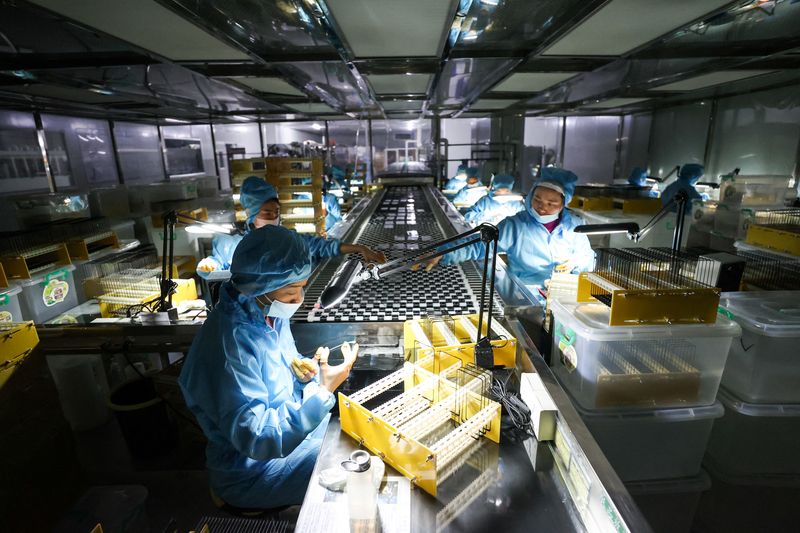By Joe Cash
BEIJING (Reuters) -China's manufacturing activity shrank for a second straight month in November and at a quicker pace, suggesting more stimulus will be needed to shore up economic growth and restore confidence that the authorities can ably support industry.
Economists upgraded their forecasts for the world's second-largest economy after better-than-expected third quarter data, but despite a flurry of policy support measures, negative sentiment among factory managers appears to have become entrenched in the face of weak demand both at home and abroad.
The official purchasing managers' index (PMI) fell to 49.4 in November from 49.5 in October, National Bureau of Statistics data showed on Thursday, missing economists' forecast of 49.7. The 50-point mark demarcates contraction from expansion.
"The domestic market cannot make up for losses in Europe and the United States. The data shows that factories are producing less and hiring fewer people," said Dan Wang, chief economist at Hang Seng Bank China.
"(The data) could also show a loss of confidence in government policy," she added, warning factory activity was unlikely to improve anytime soon as other economic problems dominate. "The priority now is clearly containing the local government debt risk and the risk posed by regional banks."
The new orders sub-index contracted for a second consecutive month, while the new export orders component extended its decline for a ninth month.
In another worrying sign, the vast services sector contracted for the first time in 12 months. The non-manufacturing PMI, which includes services and construction, eased to 50.2 in November from 50.6 last month.
China's economy has struggled this year to mount a strong post-pandemic recovery, held back by a deepening crisis in the property market, local government debt risks, slow global growth and geopolitical tensions.
The factory PMI has contracted for seven out of the past eight months - rising above the 50-point mark only in September. The last time the indicator was negative for more than three consecutive months was in the six months to October 2019.
"The hard data have held up better than the survey-based measures lately... (which) may be overstating the extent of slowdown due to sentiment effects," Sheana Yue, China economist at Capital Economics, said in a note.
"But if that starts to change, policy support will need to be ramped up further to prevent the economy from backsliding."
The patchy recovery has prompted many analysts to warn that China may decline into Japanese-style stagnation later this decade unless policymakers take steps to reorient the economy towards household consumption and market-allocation of resources.
"Today's PMI reading will further raise expectations towards policy support," said Zhou Hao, economist at Guotai Junan International. "Fiscal policy will be under the spotlight and take centre stage over the coming year and will be closely monitored by the market."
Oil prices fell in early Asia following weaker-than-expected manufacturing activity in China, the world's largest energy consumer, while the offshore yuan also slipped.
MORE SUPPORT NEEDED
China's central bank governor on Tuesday said he was "confident that China will enjoy healthy and sustainable growth in 2024 and beyond," but urged structural reforms to reduce reliance on infrastructure and property for growth.
Policy advisers say the government will need to implement further stimulus should it wish to sustain an annual economic growth target of "around 5%" next year, which would match this year's goal.
But the People's Bank of China (PBOC) is constrained when it comes to implementing further monetary stimulus over concerns a widening interest rate differential with the West may weaken the currency and spur capital outflows.
In October, China unveiled a plan to issue 1 trillion yuan ($138.7 billion) in sovereign bonds by the end of the year, raising the 2023 budget deficit target to 3.8% of GDP from the original 3%.
The PBOC has also implemented modest interest rate cuts and pumped more cash into the economy in recent months, pledging to sustain policy support.

China still channels more funds into infrastructure projects to drive growth, which likely lifted the construction index to 55.0 from 53.5 in October, though the government has been trying to reduce the economy's reliance on property.
"Despite the raft of stimulus measures announced over the past several months, we believe it is still too early to call the bottom," Ting Lu, chief China economist at Nomura, said in a note. "We expect another economic dip towards end-2023 and spring 2024."